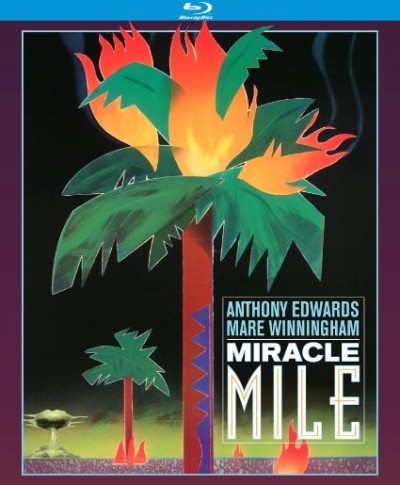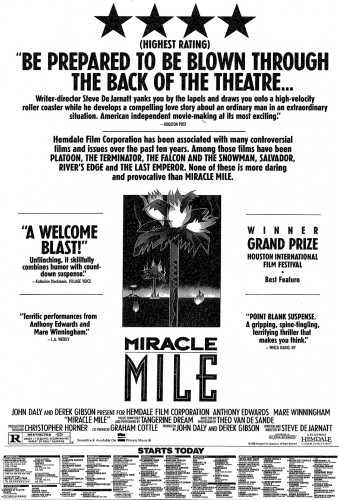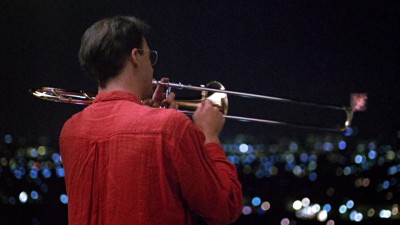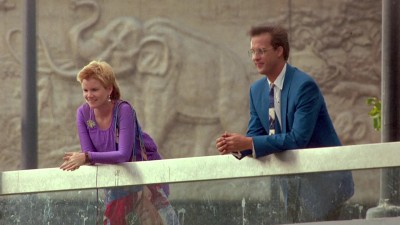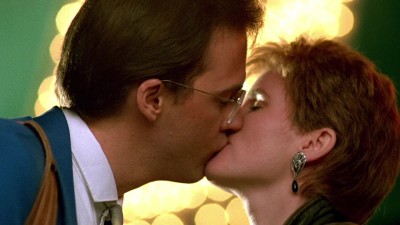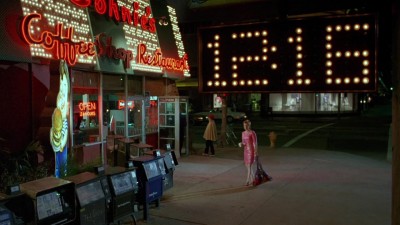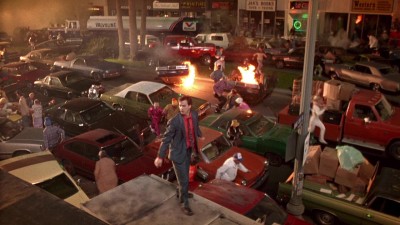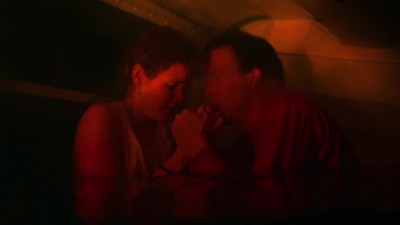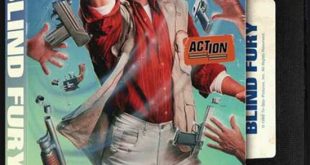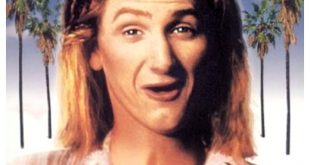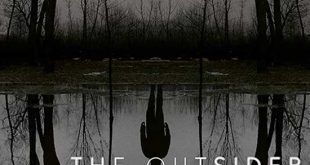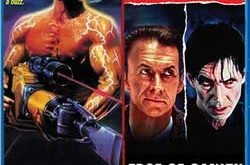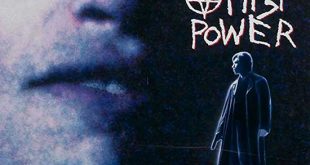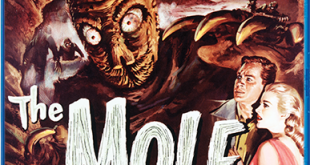SYNOPSIS:
A young trombone player meets the love of his life on the same day that he answers a random phone call predicting nuclear Armageddon within the hour.
REVIEW:
In the summer of 1989, just prior to the release of Tim Burton’s Batman, the distribution of an unheralded thriller occurred on Friday, May 19th without much fanfare. Miracle Mile, stars Anthony Edwards of ER fame and Mare Winningham as a couple who manage to bump into each other and fall in love at first sight. A good friend of mine and I saw it theatrically not too long after its initial release and I immediately loved it.
Shot nearly two years earlier on the streets of Los Angeles in 1987, it is most definitely an 80’s film, and that becomes apparent by the lack of cell phones, the older looking automobiles and the ludicrous workout garb worn by men and women alike near the end of the film.
The story itself is fairly simple and straightforward as all of the action takes place during one night and into the following morning. But there is a lot more going on here than meets the eye. Harry Washello is a trombone player with no real direction in life until he meets Julie, his soulmate.
In fact, the playfulness of their relationship is so natural and comedic that the director lulls the audience into a false sense of security, giving us the feeling that all is well (think of the relationship between the three leads in Greg McLean’s Wolf Creek (2005) just before the whole movie makes a complete detour into the depths of hell). We can’t believe that anything awful is going to befall these two characters.
After having overslept due to an electrical outage at his apartment building, Harry rushes back to Johnie’s Coffee Shop to meet up with Julie hours after the time he said he would, only to find she’s no longer there (from this point on, the movie plays out in real, onscreen time). Out of frustration he picks up a newspaper and is distracted by a phone call coming into a public telephone booth. The caller is a panic-stricken employee in a missile silo who misdialed while attempting to reach his father, and tells Harry that nuclear warheads are heading towards Los Angeles and they have roughly an hour to get away from the blast radius.
Bewildered by what he has just heard, Harry elects to share this info with the proprietor, waitress and regular patrons, who all panic and make a mad dash out of the city. Harry, however, cannot leave Julie behind, and races to find her before it’s too late. Once he does, he attempts to keep the news of the missiles a secret from her for as long as he can so as not to upset her.
The film does an excellent job of introducing us to these charming characters, then pulling out the rug from underneath us with sudden, violent scenes of mass hysteria and panic which range from people looting and fighting in the streets to an unbelievably prophetic image on a TV in a storefront window of a newsman and his camera being murdered by a stranger in the street wielding a pistol. In today’s social media inundated society, it was only a matter of time before something like this would actually happen on the air, as evidenced by the tragic shooting and killing of reporter Alison Parker and cameraman Adam Ward.
On the surface, it is a film about a nuclear attack, but there is a considerable amount of subtext going on that makes the film a fascinating subject of repeat viewing. A lot of “What ifs?” occur, such as what if Harry had not been so careless in his discarding his cigarette, and what if that bird didn’t pick it up and bring it to its nest, only to short circuit the power to Harry’s apartment building and make him oversleep? What if Harry didn’t get to the telephone booth later on and answer the prophetic phone call?
One of the things that makes the film work so well besides director Steve De Jarnatt’s script and Theo van de Sande’s colorful cinematography is the stunning score by Tangerine Dream. In the summer of 1983, I bought a ticket to War Games but snuck in to see the R-rated Risky Business. In the hopes of seeing lots of naked female flesh, I was instead enthralled by the dynamic electronic musical score by this minimalist New Age Germany-based group. I had never heard of them before, and couldn’t help but snicker at their namesake. I had no idea how many people were in the band or even what they looked like, but their music fit the movie like a glove. I searched high and low throughout record stores for months in the hopes of locating a soundtrack album (unfortunately, none was to be found until nearly six years later, roughly around the time that Miracle Mile premiered). It turns out that Tangerine Dream had already been in the business of scoring motion pictures, having provided an electronic score to William Friedkin’s 1977 remake of The Wages of Fear called Sorcerer as well as Michael Mann’s Thief (1981), Michael Laughlin’s Strange Behavior (1981), and James Glickenhaus’s The Soldier (1982 – like Risky Business, this film actually used some pre-existing studio music by the group). In the months and years to come, I would hear and greatly admire their scores to Michael Mann’s The Keep (1983) and Mark L. Lester’s Firestarter (1984). Likewise, Tangerine Dream provides an utterly original, captivating, and atmospheric score to Miracle Mile, so much so that I cannot imagine the film with any other music. A soundtrack album was released but, as is the case with most soundtrack albums of the 1980’s, not all of the music from the film ended up on the CD. Of great note is the music that plays during the film’s opening credits when Harry and Julie keep missing each other during the museum tour; Harry’s unfortunate oversleeping into the wee hours of the morning as Julie waits for him on Wilshire Boulevard (which is a slightly altered variation of the “Love on a Real Train” track from Risky Business); and the mad dash by everyone in the coffee shop to get on the road as quickly as possible and escape from Los Angeles.
All of the supporting actors and actresses in this film provide terrific performances. I didn’t even realize it at the time, but one of the two women who appear near the end of the film, brandishing machine guns in an effort to escape via helicopter, is none other than Jenette Goldstein from Aliens (1986), Near Dark (1987, which Tangerine Dream also scored), and Terminator 2: Judgment Day (1991). It’s also a real treat to see the late John Agar in a small role.
Miracle Mile was never effectively reproduced on home video very well. The HBO Video VHS cassette that was released sometime later, along with the Image Entertainment laserdisc, simply did not possess the technical ability to reproduce the cinematographer’s carefully constructed candy-colored palette. MGM/UA released it on DVD with a ludicrous cover and a single-layer transfer. All of that has thankfully been rectified with this brand-new high definition transfer by Kino Lorber, and the company has retained the film’s movie poster key art on the cover of the release. The colors are bright and colorful and pop out off the screen at you. There is some film grain but nothing too distracting. It’s almost as if Los Angeles is being viewed through the eyes of a killer clown from outer space.
As if the new transfer weren’t enough, there are a multitude of extras on here for any fan of this film. There are not one but two feature-length audio commentaries. The first is moderated by Miracle Mile super fan Walter Chaw of www.FilmFreakCentral.net with the director and they speak at length about the making of the film. Mr. Chaw has even written a book about the film, called Miracle Mile, which can be purchased here as either a paperback or as a downloadable ebook.
The second commentary, which was recorded prior to the first commentary, is with director De Jarnatt, cinematographer Theo van de Sante and Chris Horner, the production designer.
Excavations from the Editing Room Tar Pits are nearly 12 minutes’ worth of deleted scenes and dailies on VHS (in remarkably good condition) which include a short scene with actor Joe Turkel from The Shining (1980) and Blade Runner (1982).
Supporting cast and crew reunion – this is shot at the Johnie’s Coffee Shop Restaurant on Wilshire Boulevard where the film was partially shot and runs just under 15 minutes. It’s wonderful to see all the memorable performers discuss how they got their roles.
A 2015 interview with Anthony Edwards and Mare Winningham and their recollections of making the film and how they became performers. This runs just under 13 minutes.
There is an alternate diamond ending which, thankfully, was not used. The golden egg motif works at the end of George Sluizer’s shattering 1988 horror film The Vanishing, but the effect of the diamonds here comes off as whimsical rather than elegiac.
The final message of the film seems to be that the one thing we all as people have in common is our own mortality. Live life now, and don’t die alone.
Click here to order the DVD or Blu-ray from Amazon.com
Click here to order Walter Chaw’s book on the film.
 Horror News | HNN Official Site | Horror Movies,Trailers, Reviews
Horror News | HNN Official Site | Horror Movies,Trailers, Reviews
